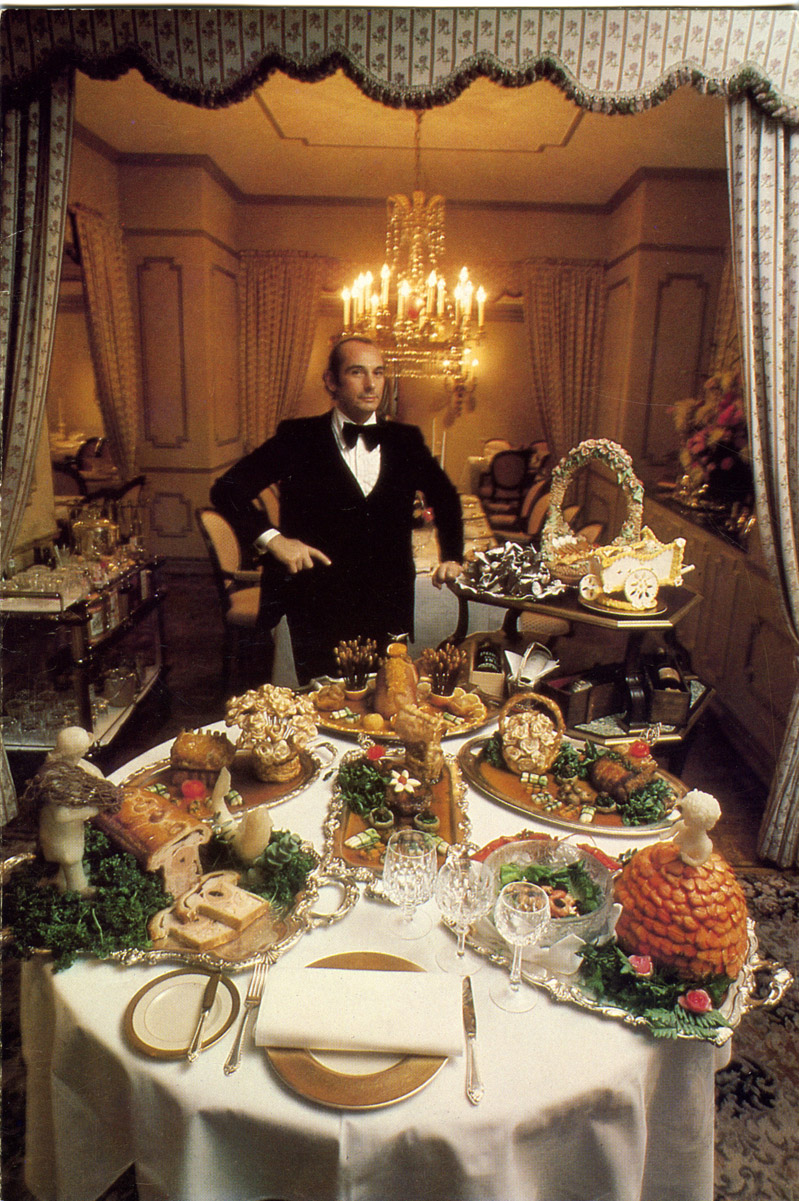September 30, 2008 |
Favorites
The Preposterous Palace

How dapper he is in velvet. Frank Valenza, Lord of the Palace, surveys the chef’s whimsies.
For cuisinary highs and giggles, for memories of wearing floor length velvet and feeling like Catherine, Empress of Russia, I will tell about my first dinner at the preposterous and preposterously delightful Palace. It arrived on the farthest edge of East 59th Street in 1975, beribboned with a disarming mix of arrogance and insouciance dispelled by its unlikely creator, Frank Valenza, a failed actor whose successful Proof of the Pudding restaurant was mostly written off by serious critics as tacky show biz. Touted by Valenza as "the most expensive restaurant in town" with its $50 prix fixe, the timing of Palace was especially provocative. New York teetered on the edge of bankrupcy, a fat, rotten Apple. In my review I greeted it as an “acute case of terminal decadence.” It was pretentious (that unlisted phone number). It was silly. But I had to admit, it was wonderful.
"Tucked discreetly into the grand, new, virtually empty Sovereign apartment house, there is no doorman, no bugles, just a brown canvas awning. Inside, subdued elegance, very beige, rather dowager Park Avenue with its pastel flowered carpet, graceful love seats, silk-upholstered armchairs, ivory rosebuds and an incandescence of perfect lighting.
Valenza, stands stage center beside wife Bibi in her clinging evening gown. He gave her a million dollars to put all this together, he will tell you. No need to ask. He’ll tell you the price of everything anyway. He stands in an actorly pose, chin up, dark and handsome in formal black velvet, one ruffled sleeve hanging out, quite dazzled with what he and Bibi have wrought. Now, I think, he is going to have to learn that it is not pronounced fwa gwa.
A comic opera mâitre d’ helps us consult l’Escriteau. 'Everything is written in the original old French,' our guide notes and giggles. I like that he knows how silly this is. Will we have caviar from Russia? Lobster and artichoke in a nutty vinaigrette? Oysters peppered with sevruga? No, we will have perfect Scotch salmon rolled around crème fraîche bearing two proud hills of caviar and tucked into a flaky pastry boat for Monsieur and for Madame, four thin circles of beef, daringly raw, silken almost sweet, under a wondrous mustard sauce.
Chef Claude Baills kitchen is already an accomplished atelier for pieces montées, elaborate decorative pieces on every silver serving tray, a banquet tradition more suited to Versailles. A fisherman’s wife sculpted in lard, her skirt petalled with lobster tail shells, stands guard over the lobster bisque. The bisque with its cognac-flamed lobster and truffle bits lurking below is too thick but small matter. I am in a near swoon over the magnificent cream of mussel soup with saffron threads and a bobbing of tiny bay scallops, barely cooked. I haven’t had time to be jaded, I’m not even blasé. In 1975, the great dining revolution is barely coming to a simmer. Each new taste is a thrill, unlike today where we have tasted it all.
A clipper ship, its toast sails glazed to a ceramic sheen, rides the presentation tray of the next course – a large gathering of obese snails in a zesty aromatic sauce. The uncooked tower of fettucine leans over a serving of angel hair noodles in a double truffle bath – julienne of black truffles dropped into a puree of white. Silken lemon ice on a swatch of cassis in a frosted compote does indeed clear the palate for côte de beouf, tender and rare and gussied up to a giggle with a Madeira-scented sauce, chicken dumplings and white truffles afloat, further garnished with a whole peeled tomato wearing a blossom of zucchini thins, mounded with truffle 'pollen.'
About now I am happily smashed from the $11 half bottle of Pouilly Fumé followed by a Léoville Las Cases, 1962. An elegant, too vinegary salad precedes the cheese, my favorite triple crème in those days, Explorateur, to eat with only the tiniest pang of guilt because cholesterol had not yet been invented. Memories of sweet three-star madness in Lyon and Roanne are revived by the arrival of Lilliputian pastries, éclairs, frosted puffs, small tarts in a wheelbarrow made out of sugar, and petits fours presented in a wicker basket woven of pastry dough wound with candy ribbons and sugar roses. Valenza himself wheels over a trolley of after-dinner potions. The trolley costs more than a Cadillac, he notes.
The check, presented in duplicate on heavy stock in an envelope, is sobering: $161.50 including tax, tips already allocated for those who might be too smashed or too tight to multiply: $5 for the mâitre d'’, $22 for the waiter, $7 for the captain. $2 for the wine steward, a total I later calculate to be 24%. I wonder if the Palace’s big spenders will rebel at enforced magnamimity.
Funny what can happen when one is outrageously pampered…you do start to believe you deserve it."